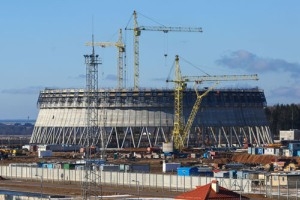Ru
|
Eng
Multiple redundant safeguards in Belarusian nuclear power plant
03.03.2016

The Belarusian nuclear power plant has multiple redundant safeguard systems. Belarusian Deputy Energy Minister Mikhail Mikhadyuk made the statement in an interview with the Lithuanian newspaper Lietuvos Rytas, BelTA has learned.
“When we were choosing the design of the future Belarusian nuclear power plant, we carefully studied all the available proposals from nuclear energy technology vendors. After carefully weighing all the pros and cons we opted for the Russian design AES-2006, which features a WWER-type reactor with the output capacity of 1,200MW. The water-moderated reactor technology is the most thoroughly tested one at present. The technology is also the most popular one in the world,” noted Mikhail Mikhadyuk.
The AES-2006 design fully complies with norms of the International Atomic Energy Agency and the European Utility Requirements for Light-Water Reactor Nuclear Power Plants (EUR Group). The same design has been chosen by other countries such as Hungary, Finland, Turkey, Vietnam, Bangladesh, India, and China.
This is why Mikhail Mikhadyuk referred to statements made by Lithuania representatives, who claim that Belarus is building a nuclear power plant, which is absolutely unsafe and fails to comply with international requirements, as absolutely incomprehensible. “Any nuclear energy specialist can confirm that such claims are absolutely unreasonable,” he stressed.
The AES-2006 design (3+ generation) stems from AES-92 and AES-91/99 designs (3 generation), which are highly praised by specialists. By the way, these designs are viewed by Lithuanian experts as possible options for the Visaginas nuclear power plant.
The AES-2006 design incorporates a unique combination of active and passive safeguards. The safeguards include a core catcher that will prevent molten nuclear fuel from leaking into the outside world, the double protective shell of the reactor that will prevent radiation from spreading beyond the reactor building and can protect the reactor from external impacts including falling aircraft. The nuclear power plant is designed to survive earthquakes with the magnitude of eight points, hurricanes, floods, and explosions.
An analysis carried out by specialists demonstrates that if the Fukushima nuclear power plant had incorporated similar safeguards, the accident of the same scale could have been avoided.
“We have chosen a state-of-the-art design that incorporates many redundant safeguards. The nuclear power plant is being built in strict compliance with the design documents and the quality of the construction work is closely monitored,” summed up Mikhail Mikhadyuk.
NEWSWIRE
17.07.2024
02.07.2024
27.06.2024
21.06.2024
19.06.2024
06.06.2024
06.06.2024
06.06.2024
06.06.2024
06.06.2024













